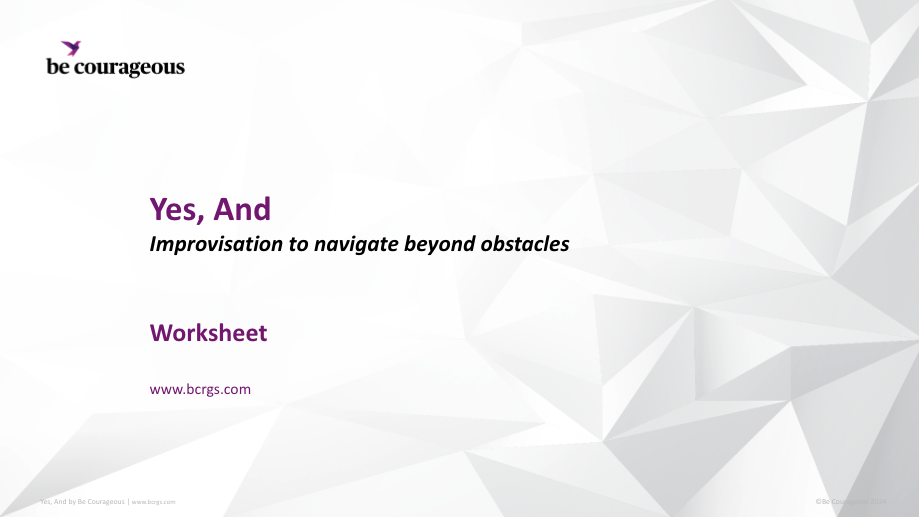Just as improv actors step onto the stage without a script, business leaders often must navigate uncharted waters and turn them into opportunities to innovate.
Remember the show, “Whose Line Is It Anyway?” A handful of brilliant comedians, including regulars Wayne Brady, Colin Mochrie, and Ryan Stiles were handed situation “set-ups” from the audience. On the spot, they’d have to improvise on their feet to create skits and songs in front of a live audience, from prompts like, “You’re going through the TSA line at the airport….as a singing elephant.”
You might be thinking, “I love comedy and improv, Kyle, but what does it have to do with my business or team growth?”
Improv in the business world
We’ve been in situations in companies and teams worldwide lately that have needed serious improvisation skills to help people navigate change and transformation.
Many leaders and their teams are in denial about the realities in front of them, whether it’s an AI integration into their workflow, a re-org, or a disruptive competitive company or product arriving on the scene and completely altering the playing field. People have been reacting almost immediately in fear and a “flight, fight or freeze” manner, resisting their new reality.
This is where the ability to improvise is powerful.
Improvisation skills = a superpower of the now and future
Some systems, organizations, workflows, tools, and attitudes may have worked for getting to where you are, but they may not necessarily work in the future. It’s not just components of a system that are changing; it’s the entire system transforming, making current systems obsolete.
Instead of fighting reality and becoming stuck, spinning your wheels in resistance to what is, try one of the tenets of improvisation. You’ll find yourself better at thinking on your feet, adjusting to new scenarios and situations, and avoiding hitting blocks and derailers, where no way forward is clear.
When you improvise, there’s always a way forward.
Five ways agility and quick-thinking of improvisation skills can help:
-
- Increased confidence: You’ll feel more certain you’ll know what to do in uncertain situations.
- Improved communication and self-expression, especially non-verbally.
- Built rapport with your teammates.
- Accelerated creativity and critical thinking to allow you to leverage what is and quickly identify ways forward.
- Developed ambidexterity skills: You’ll know when to operate and execute, and when the right time to innovate and transform is.
Improvise with your best with the tools you have at any given moment. It is a key characteristic of courageous leadership.
You can only play and improvise with the deck of cards you have. The longer you spend wishing you had different cards, the more paralyzed and limited you’ll be.
“Yes, and” improvise
Improv comedians aren’t allowed to say, “No, I’m not going to be a singing elephant in the TSA line, I’m going to be a dancing cheetah working at DMV.” Accepting what the audience or other actor(s) gave you to work with is integral to the craft of improvisation.
When a change, shift, disrupter, or new direction is presented to you, or even in a simple conversation where your colleague is sharing an idea, try one of the core improvisation skills, called, “Yes, And.”
“Yes, And” means you accept what another person says or what a situation is, and you come up with the next move or idea based on what is given.
For example, say your team is about to get absorbed into another department, reporting to an executive you don’t know well and have heard negative feedback about. Rather than fight the organizational change, try, “Yes, And.” Okay, yes, I understand we’ll be reporting to Joe, now, and I’m going to set up a meeting to get to know him better and share how I contribute to the team.
Avoiding, “Yes, but”
An important nuance is that it’s Yes And, not “Yes, but.”
The “but” turns your thinking to negativity and anchors on a block with no way forward. Going back to the “jerky Joe” situation:
Yes But: “Yes I accept I’m now reporting to Joe, but I hate confrontation.”
Yes And: “Yes I accept I’m now reporting to Joe and I’ll partner with my HR team to ensure psychological safety for myself and my team.”
Do you hear the difference between the “but” and the “and?”
“And” provides a way forward.
“Yes, and” in action
Recently, we ran an exercise with a global cosmetics company. We asked the team to imagine they lost 100% of their market overnight because of a disruptor competitor that changed what was once common human behavior. What would they do? How would they improvise and respond in a way that would maintain their best-in-market positioning, retaining their loyal customer base? AND, quitting and giving up was not an option! Within an hour, the team discovered new opportunity areas they all aligned on. Powerful!
“Yes, and” reduces stress (and can even save lives!)
I’ve been inspired by the work of author Byron Katie over the years. You may know her book, Loving What Is. (Fun fact, I met my wife and co-founder of Be Courageous, Jenna Hermans at a Byron Katie seminar).
Katie advises looking at what’s coming at you and saying, “Yes, I accept this is what is happening,” and “Let me get curious about where I can take this now.”
The Apollo 13 mission is a prime example of creative improvisation under extreme pressure.
After an oxygen tank exploded on the spacecraft, faced with dwindling power, a buildup of carbon dioxide, and the challenge of adjusting their trajectory, both the astronauts and NASA engineers improvised solutions with limited resources. They devised a way to adapt the command module’s carbon dioxide scrubbers to fit the lunar module, using only the materials available such as duct tape and plastic bags.
Read that again: Duct tape and plastic bags helped get them home from space.
Ingenuity in crafting makeshift solutions in a life-threatening scenario saved their lives.
When an obstacle comes your way, look at what’s around you to help you navigate through it. Don’t stay stuck denying reality. Look for your version of duct tape and plastic bags.
More examples of bad news turned into “Yes, and”
I just lost my talent pipeline to another organization. | Yes, and I’m going to review what their offerings are and how I can bolster the offerings at my organization to attract more people again. |
We’re having major supply chain issues and are struggling to meet demand. | Yes, and I’ll look into partnering with another organization to create supply efficiencies or research new products that aren’t as restricted. |
Another company is buying ours; I’m afraid I will lose my job. | Yes, and I’ll research that company and find where my skill sets are needed and have an open mind to advocate for my role; this may create more opportunities for me. |
“Yes, and” fosters creativity, curiosity, and courage
The faster you accept reality for what it is and improvise, getting creative, curious, and courageous, the faster you’ll emerge with newfound confidence, growth, and breakthroughs.
Just as improv actors step onto the stage without a script, business leaders often must navigate uncharted waters and turn them into opportunities to innovate.
Adopt a “Yes, and” mindset to encourage ongoing positive action and build upon ideas. Try running a fun improvisation exercise with your team, ala “Whose Line is it Anyway.” In playful exploration, some of the most compelling, out-of-the-box business solutions can be found. Follow the “haha” for an “A-ha” moment!
Co-writer: Shannon Geher//Research: FIN
Courageous Relationships
Workshop Series
In this eight-week interactive workshop and coaching series, your team will elevate trust, collaboration, and performance.



